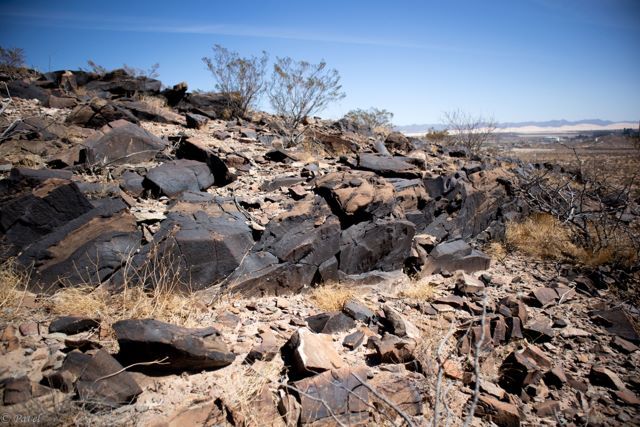The Martian Varnish Quest to Uncover Life's Footprints on the Red Planet
Discover the quest to find life on Mars by analyzing varnish on rocks in desert environments in Mexico. Researchers are on the hunt for biomarkers in varnish with high concentrations of manganese.

Regardless of their size, some rocks in arid or desert environments in Mexico have a kind of film or coating, better known as varnish (black or red), which may hold clues to the search for life on Mars.
Following in the footsteps of his teacher, the renowned astrobiologist Rafael Navarro González, Pável Ulianov Martínez Pabello, a postdoctoral researcher at UNAM's Institute of Geology, analyzes in depth these coatings, which are made up of 70 percent clay and 30 percent iron and manganese oxides and "grow" from one to 40 microns every thousand years.
"The particularity of the varnishes is that they have high concentrations of manganese, which is only comparable to the nodules at the bottom of the sea." "It is important because manganese is part of some metabolic pathways of microorganisms, and microbiological structures have been found in all the varnishes that have been studied on Earth," said the doctor in Earth Sciences.
Based on this evidence, the question of whether life is needed for the varnish to form comes up. This is especially true since the Curiosity and Perseverance missions of the National Aeronautics and Space Administration (NASA) recently found similar films on rocks on Mars that had a lot of manganese in them.
The UNAM's Faculty of Sciences has also spent three years looking at the varnishes in the deserts of Chihuahua, Sonora, and Nuevo Leon. They did this by using the same methods that robots on Mars used to look for signs of possible life.
"We have mineralogically and geochemically characterized the varnishes." "We are about to start a second part with a new project to study the varnishes from a more microbiological and biochemical point of view; we are going to look for biomarkers together with the Autonomous University of Ciudad Juarez and the Astrobiology Center of Madrid," detailed the researcher.
As one of its first results, it has been found that desert varnish doesn't seem to have a favorite type of rock since it grows on almost any kind of lithosphere. And while the analyses haven't directly shown that microorganisms are involved in the formation of varnish, the fact that they are in all of the samples shows that they live there.
Extremophiles can live in arid places with high radiation and extreme temperatures because they can fix manganese and use it in their metabolism. For example, they can live in the Sonoran Desert, which can get up to 50 degrees during the day but drops below zero at night.
In the analyses they carried out, they found bacteria, cyanobacteria, and microscopic fungi that meet this profile.
"The key is in the manganese because the very large concentrations that exist in the varnishes are similar to the manganese concentrations found by NASA's Curiosity and Perseverance missions." It is very new for these missions to find these concentrations in this type of Mars coating, and at this moment they are being collected by Perseverance to be sent to Earth with the Mars Sample Return mission, he said.
In the past, the Red Planet was warmer than it is today, with a denser atmosphere and larger oceans and lakes, and if these conditions dominated in the past to develop a varnish, there are likely traces of life trapped in Martian varnish.
Martinez Pabello was the last student that Rafael Navarro Gonzalez doctored. During his undergraduate and master's studies, he replicated biological experiments from NASA's Viking mission, and in his Ph.D., he simulated electrical discharges in sand whirlpools to see the formation of oxidizing compounds like perchlorates and nitrates. Today, he applies what he learned but focuses on varnishes as Mars analogs.
At the moment, the young researcher works with the Astrobiology Center of Madrid in Spain. This center is a part of the European Space Agency (ESA) and is known as NASA's Astrobiology Institute.
"Our samples competed for the ExoMars robot, which was to go to Mars this year, to use and calibrate its instruments in Mexican varnishes, but due to the war the whole mission was canceled since Russia was the one who would carry this ESA robot." "NASA just told us that they are going to restart this mission, and we plan to send our samples again for the preliminary analysis," he said.
The next step in Martnez Pabello's research is to prove that these desert glazes are the best model to study the potential Martian glazes being found by NASA.
He hopes to find the best biomolecules or biosignatures preserved in these and look for them on Mars with the new analyses, as well as study how different oxidizing salts (such as perchlorates) and radiation affect the degradation of ancient biomolecules. So, the researcher plans to look for more samples in Gobi Altai, Tajikistan. He is also about to get samples from the Atacama Desert, and he is putting together an expedition to Antarctica to collect varnish samples from that part of the world, which is the most like Mars on Earth.




